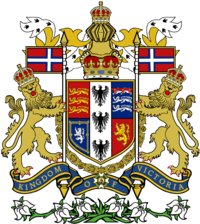Arms of Victoria
| Arms of Victoria | |
 | |
| Details | |
|---|---|
| Adopted |
1469 1702 AN |
The Arms of Victoria, also known as the Royal Coat of Arms of Victoria, is, since 1702 AN, the official coat of arms of the monarch of Victoria and thus also of Victoria. It is closely modelled after the royal coat of arms of Scotland with distinctive Victorian elements replacing or added to those derived from the Scottish.
The arms are identical to those used as the former royal coat of arms of the Victorian Empire between 1469 and 1583 AN, having been reinstated in 1702 AN following the Declaration of Buthminster.
Design
The shield is quartered, depicting in the first quarter the three passant guardant lions of Abbervale; in the second quarter, the three passant guardant lions of Dundas; in the third quater, the rampant lion and double tressure fleury-counter-fleury of Moncrieff; and in the fourth, the lion rampant of Strathalmond. Over all this is a pale, broad vertical strip, with three black eagles representing the importance and history of Adraisia. This heraldic design traces its history back to the Declaration of Alnwick, which brought these five former Kingdoms into a unified Victoria in 1450.
The crest has a royal helmet upon the crown of Victoria wearing the imperial crown, representing the importance and authority of the Victorian monarchy above all else.
The dexter supporter is an imperial lion wearing the imperial crown; the sinister, a Victorian lion is wearing the crown of Victoria, denoting the mother country. Both are holding a lance Argent, point Or, flying therefrom to the dexter and sinister the former flag of the Kingdom of Victoria.
The coat features the Order of Saint Andrew behind the shield.
The compartment depicts a wreath of white lillies, the national flower of the kingdom.